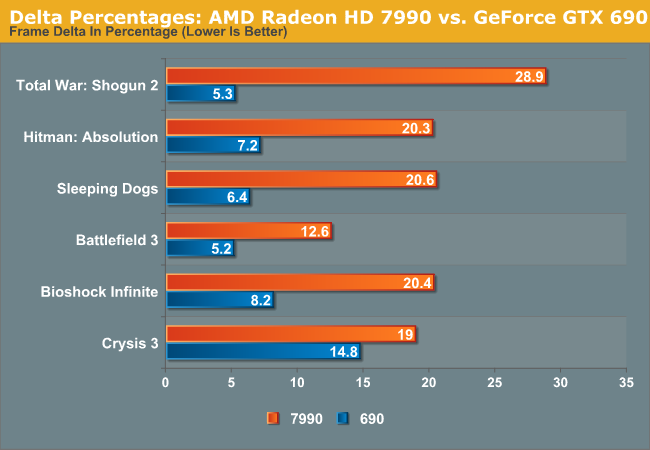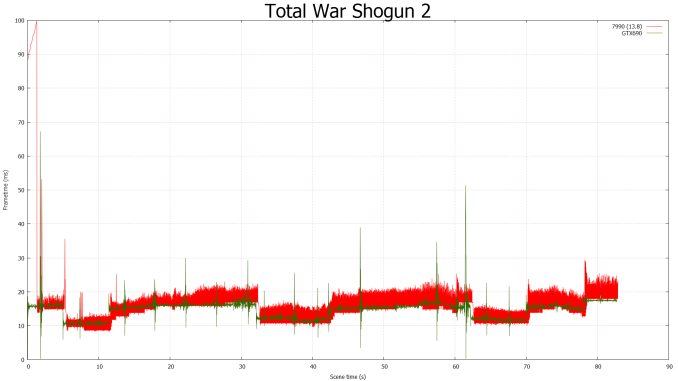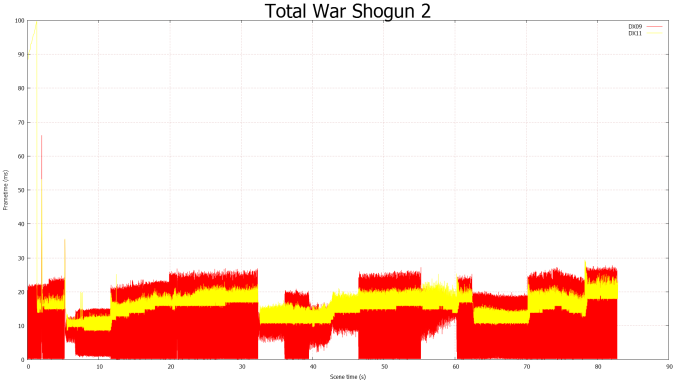AMD Frame Pacing Explored: Catalyst 13.8 Brings Consistency to Crossfire
by Ryan Smith on August 1, 2013 2:00 PM ESTCatalyst 13.8 Results in Summary, Cont
Up next, let’s take a quick look at how the 7990 with frame pacing compares to NVIDIA’s GTX 690. NVIDIA’s frame pacing has been the gold standard thus far, so let’s see how close AMD has come to NVIDIA on their first shot.

Frankly the results aren’t flattering for AMD here, although keeping things in perspective they’re not terrible. In every last game GTX 690 has much lower frame time variability than 7990. NVIDIA has been working on this problem a lot longer than AMD has and it shows. Ultimately while it’s true this is an absolute metric when it comes to comparing results – AMD experiences more than two times the frame time variation in 5 of the 6 games – keep in mind we’re looking at the variance in frame times, rather than the frame times themselves, a first order derivative. What it means is that AMD clearly still has room for improvement, but AMD’s approximately 20% results are not a poor showing in this metric; for every individual there exists a point below which the frame time variations cease to be perceptible.
While we’re on the matter of this comparison, it’s very much worth pointing out that while AMD can’t match NVIDIA’s delta percentages at this time the same cannot be said for runt and dropped frames. Throughout our tests on Catalyst 13.8 AMD delivered 0 runt frames and dropped 0 frames. This is a massive improvement over Catalyst 13.6, which would regularly deliver runt frames and drop frames at times too. In fact even NVIDIA can’t do this well; the GTX 690 doesn’t drop any frames but does deliver a small number of runt frames (particularly towards the start of certain benchmarks). So in their very first shot AMD is already beating NVIDIA on runt frames, a concept pioneered by NVIDIA in the first place.
We’ve also posted the FCAT graphs for the 7990 versus the GTX 690 below. We can clearly see the higher variation of the 7990, while we see a few more instances of late frames on GTX 690 than we do 7990.
Moving on, we wanted to quickly compare D3D9 to D3D11 performance on the 7990. As a reminder AMD’s frame pacing mechanism isn’t enabled for D3D9, so this gives us a quick chance to look at the difference. The only title in our collection that is D3D9 capable is Total War: Shogun 2, so we’ll use that.
And there you go. Frame pacing is not available on D3D9, leading to much more variable results for the 7990 when using the D3D9 path, even though it’s otherwise faster due to the simpler effects. AMD will ultimately address D3D9 in a further phase, but in the meantime this reinforces the need for a switch to turn off Crossfire on dual-GPU cards like the 7990. NVIDIA allows this, and AMD lets you do it on multi-card setups, but with the 6990 and 7990 you are unfortunately locked into Crossfire mode at all times.
Finally, while it’s not something we can properly measure, we did want to touch upon the matter of input lag. AMD’s earlier position that frame pacing and input lag are inversely related was not wrong. At some level adding frame pacing is going to increase the input lag due to frames being held back. The question is, to what extent and is it acceptable?
The short answer is that while we can’t really give the issue the full attention it deserves without a high speed camera (something we don’t have), subjective testing is quite good. If there is a difference in input lag from enabling frame pacing, it’s not something we’re able to perceive. Despite AMD’s concerns about input lag from what usage testing we’ve done we have no problem saying that enabling frame pacing by default was the right move. In our experience there’s simply no reason not to enable it.


















102 Comments
View All Comments
chizow - Saturday, August 3, 2013 - link
Written on the walls at AMD Driver HQ I'm sure, quickly referenced when questioned about microstutter being worst on CF.krutou - Friday, August 2, 2013 - link
BUT, BUT, BUT, RADEON PRO?!?LordOfTheBoired - Saturday, August 3, 2013 - link
Took them by the hand? Looks more to me like "waited until people cared, then released a benchmark to prove they didn't have the problem, while offering no constructive commentary."And the hell of it is... AMD's stance makes sense. This IS a market that hates VSync because ZOMG LAG. "The market" has made it ABUNDANTLY clear that they have no interest whatsoever in technologies that improve the visual experience at the (real or imagined) cost of responsiveness.
But apparently that's only true when there's the visual equivalent of a record skip on your screen and not when it's a subtle frame rate fluctuation. The former is a good thing because it means you "aren't lagged", the latter is a horrible thing because it means you "aren't lagged".
chizow - Wednesday, August 7, 2013 - link
@LordOfTheBoired - this is the type of indignant attitude that got AMD and their fans in this predicament to begin with.mikato - Wednesday, August 7, 2013 - link
Well one result of Nvidia releasing the software was to allow tech journalists to shine a bright spotlight on a problem of their competitor's products. Your "holding AMD by the hand" idea is pretty amusing.novastar78 - Wednesday, August 7, 2013 - link
What's sad is that AMD has ripped ATi to shreds to the point where they are spread pretty thin. Just getting a working product out the door is a task. You are being waaay too hard on them.They were using traditional methods to test and frankly it's not so unimaginable that they were caught by this. Granted, maybe it should have been caught sooner, but to demonize them or put them down for it seems a bit harsh.
They know now that it's a big problem are definitely committed to fixing it. You can clearly see that they are trying to stabilize the company and there is lots of turmoil. The moves they are making and the people being brought on board are a good sign. There is definitely a process change that needs to happen but when the tree is being shaken so many times too many apples can fall.
Give it some time, I think we will see great things form them over the next few years.
Wreckage - Thursday, August 1, 2013 - link
It did not help that certain people were claiming that AMD does not have a stutter problem.DanNeely - Thursday, August 1, 2013 - link
The problem is that AMD didn't think they had a stutter problem; or more precisely, until 3rd parties shoved the reality in their face they assumed (without testing) that they and nVidia had equal amounts of the problem.I suspect at one point in the past they were right; and that the genesis of nVidia's "years in the making" tool to measure the problem dates back to when they discovered it was a problem internally and began working on fixes so that they could announce the same tool at the same time that their drivers had a negligible impact from it. It'd be interesting to see what would happen if someone tested SLI card/driver configurations from a few years ago to see how well nVidia did at the time.
BrightCandle - Friday, August 2, 2013 - link
NVidia has had this fixed for a lot longer than that. The 680's were noticeably smoother on their release day compared to the 7970 crossfire. NVidia has claimed they have been fixing this since the 8800 and there is no reason not to believe them as HardOCP and other review sites have been noting the difference for years.HisDivineOrder - Friday, August 2, 2013 - link
Exactly. This has been a problem for as long as there has been Crossfire. I think a lot of people are so shocked by this fact (because some of them owned Crossfire and just dealt with it and didn't realize they were getting shafted) they can't accept it.Yes, you got reamed. Yes, for years, you were using Crossfire and suffering from microstutter when you needn't have to. Yes, AMD took you for a ride. It's so infuriating it drives people not to want to believe it because to believe it would be so horrible as to suddenly be intolerable.
Do what most people do. Just stick with nVidia since you know they do proper testing. Boycott AMD for a five year period and come back once you're sure AMD's got their act together.